The increasing need for data transmission has exposed the inadequacies of the global network. This is where the transformative 400G ethernet technology rollout will impact the future of broadband networks. This advanced version of Ethernet will enable faster data transfer speeds while lowering lag times and optimizing the connection, an ideal solution for organizations involving data-intensive workloads such as cloud services and high-frequency trading. This paper will analyze the design, the development history usage scenarios, and core advantages of 400G ethernet technology and its ability to alter the face of network engineering and satisfy the most outstanding needs of the digital world.
What is 400G Ethernet, and Why is it Important?
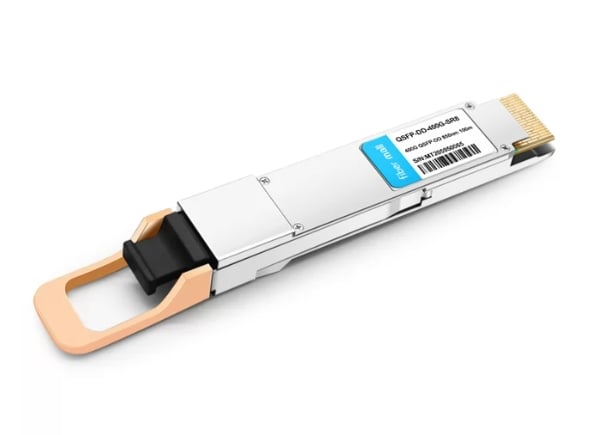
The increasing bandwidth requirements in data networks are addressed by introducing 400G Ethernet as the next step in Ethernet technology. This technology, which enables a data transmission speed of a capacity of up to 400 gigabits, provides for the soaring demand for data transmission placed by the 5G, cloud computing and AI technologies. The performance of data centers and networking services is highly dependent on the promotion of 400G Ethernet since it reduces network latency and increases the efficiency of networks which in turn provide the necessary bandwidth for advanced and wide area applications. The amount of data traffic and number of connected devices grows constantly, and in meeting these and future requirements, 400G Ethernet is essential.
Understanding 400G Technology
In October 2023, you were last able to access databases. To that date, it has been possible to use 100G Ethernet and 400G Ethernet, the latest technology that can transfer as much as 400 GB per second. The latter’s l capacity has quadrupled over the former’s. This is a leap concerning transmission capability as the reach of 400G Ethernet expands; this leap can be attributed to advanced modulation techniques and the increased density of optical components as they allow enhanced above throughput. However, power consumption does not expand. In a sense, there is no need to expand the power supply. For 400G, such an expansion is critical because it was developed to meet the requirements of current technologies: five-generation mobile communication systems, the Internet of Things, and various virtual reality technologies. This provides 400G Ethernet with the capability to help network infrastructures meet the tremendous demand for data. With such a capability, there is the ability to ensure operational efficiency in a wide range of sectors.
The Role of 400G Ethernet in Data Centers
The emergence of 400G Ethernet is vital in today’s data centers as it addresses bandwidth and performance demand. As data centers become the backbone of digital transformation, they are under huge strain to accommodate more data and support applications such as cloud services, big data analytics, and AI. 400G Ethernet addresses the technological infrastructure gap needed to efficiently market this data explosion. Currently allowing for higher throughput and lower latency periods, these data centers process more data while preventing clogging of the processes, increasing efficiency. This also allows 400G technology to optimize performance while reducing waste by improving energy consumption. As more people seek for a better network solution, the transition towards more robust data center capabilities seems to be dominated by the growth of 400G Ethernet.
How 400G Compares to Previous Standards
When comparing 400G Ethernet to 100G and 40G, the most noticeable difference is the increase in data transmission rates, which offers 4 times the speed of those earlier generations. Such an increase in bandwidth has come about due to improved optical technologies and modulation techniques. The XX-100G Ethernet standard mostly uses a non-return to zero (NRZ) encoding scheme, whereas 400G Ethernet uses expansion to PAM4, which enables encoding two bits with each symbol instead of just one. Furthermore, with the advent of 400G Ethernet, mascara-packed optical transceivers have become common to accommodate larger data packages. In this way, 400G Ethernet addresses the increasing needs in infrastructure as they are faster, more scalable, and more efficient, which are highly needed to support future generation technologies.
How Does 400G Ethernet Work?
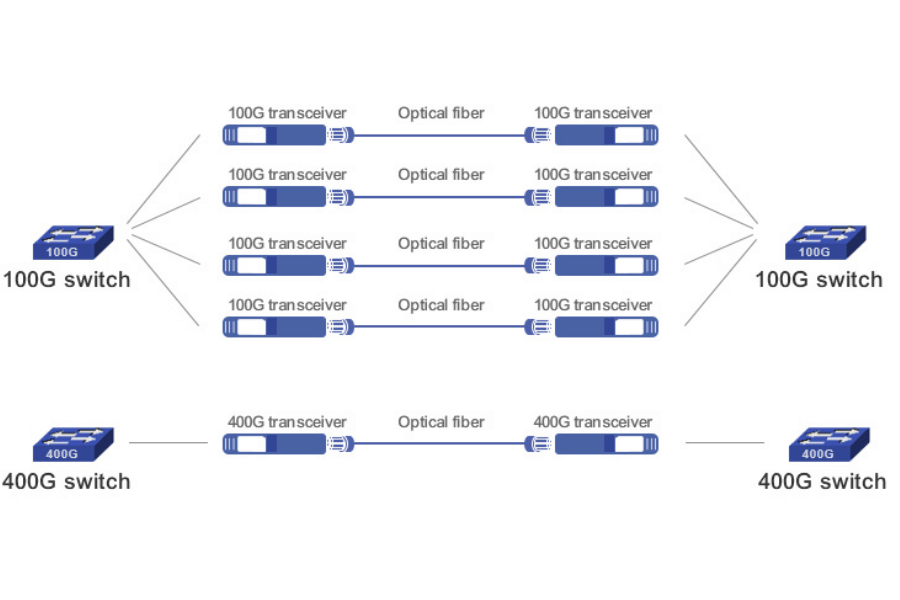
Exploring the Architecture of 400G Networks
The designed architecture of 400G networks comes from a chain of technologies aimed at enhancing speed and efficiency. Central to their design are network processors and silicon photonic devices that can deliver enormous quantities of data. However, the core of the operation of 400G lies in PAM4 modulation, which allows two bits to be encoded in a symbol instead of one, as is the case with the traditional NRZ protocols, thereby making the use of a wider band possible. This technique of modulation allows for higher data rates on previously installed cables, thus increasing bandwidth without having to replace machinery significantly.
At the same time, 400G networks are equipped with advanced digital signal processors (DSPs), which possess sufficient error correction ability and data integrity during transmission. The architecture also incorporates more flexible grid and wavelength-division multiplexing (WDM) technology, enabling a change in the bandwidth usage of reconfigurable devices depending on demand. These solutions allow efficient traffic control on different network layers while improving delays and throughput. This complements the quality of service and enhances the 400G network architecture, making it flexible enough to handle the increasing demand for internet connectivity.
The Impact of PAM4 Modulation
400G Ethernet relies on PAM4 or Pulse Amplitude Modulation with four levels. A single bit is encoded using NRZ or non-return-to-zero, using two levels as a symbol. PAM4 consists of four amplitude levels for each symbol, allowing two bits to be encoded. It allows for double the data volume to be transmitted within the same width, making PAM4 essential for all future Ethernet standards. As helpful as it is, PAM4 also operates at a high level, leading to high noise levels and reduced signal integrity. Advanced tools like Forward Error Correction (FEC) are used to counteract these negative effects. It’s clear from the above that as integrated networking progresses, PAM4 sends up a new lifeline for the steep data rate growth without compromising on the limitations of the existing physical infrastructure.
Fundamental Components: Transceivers and Connectors
As for high-speed signal transmission units, transceivers and connectors can be described as inevitable attributes of 400G network architecture. The Quad Small Form Factor Pluggable Double Density (QSFP-DD) is an example of a transceiver engineered to be compact and high-density with the capability of accommodating 400G Ethernet and beyond. For the QUAD SFP transceiver, eight ports or electrical lanes are used, each with a potential of up to 50Gbps, translating to a total of 400Gbps bandwidth. In addition, power consumption and signal integrity are two essential features that must be maintained, mainly when tightly packed elevated central housings are used. Alternatively, connectors are critical elements in creating dependable network devices with fiber optic links that reside in or form a network. For multi-core fiber usage, MPO connectors are best suited for 400G applications regarding high bandwidth and lower loss under conditions providing for efficient data transfer. So, these components will cause the steady development and growth of the network potential, meeting the growing industry’s appetite for throughput and low latency.
What are the Benefits of 400G in Data Centers?
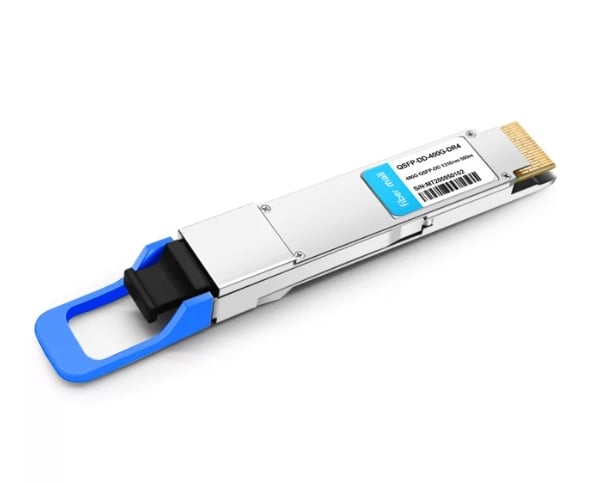
Enhancing Bandwidth and Data Rate Efficiency
I have witnessed improved bandwidth and efficiency owing to a network combination of data centers over 400G technologies. This change opens new boundaries for scalability and traffic management, which is quite important owing to the accelerated rise of data-driven applications. There are also huge strides in the effectiveness of power consumption and the economic viability of the network since energy-efficient 400G solutions often have advanced technologies that focus on energy saving while performance is at the maximum. Moreover, the volume of incoming data complements nascent technologies such as artificial intelligence and machine learning, ensuring that the data center’s operation remains relevant amidst the changing nature of the digital world.
Supporting Future Data Center Networking Demands
Several increasing network demands concerning future data center networks are considered to be met by the recent advancement of 400G technology. Leading sources in the industry point towards increased bandwidth and efficiencies in data rates to address the need for faster networks and effective data processing. However, it should be noted that future technologies are expected to develop and be driven by more vast amounts of data. Further, the energy efficiency improvements inherent in 400G solutions make them practically feasible and offer 400G, which is carbon neutral, rendering large-scale data centers environmentally friendly. Finally, the engagement and integration of largely untapped technologies, including IoT and AI, also show that 400g systems are very flexible and expandable without the need for high increases in capital expenditures. In addition, they provide such a performance that allows them to meet trends in the development of data centers and their technologies. Therefore, it can be concluded that 400g technology paves the way for the evolution of future data centers.
Reducing Latency and Increasing Speed Ethernet
In response to the dilemma of resolving the latency issues and expanding the speed of Ethernet, I have gathered insights from the most advanced research available. Firstly, new technologies in the field of Ethernet, like upgraded modulation schemes and improvements in data pathways, are essential in achieving the aim of reducing latency. Secondly, latency is automatically lessened when switching to higher Ethernet speeds, e.g., 400G, as it allows fast transfer rates. At last, using AI-powered network management solutions allows for active adjustments of parameters to reduce the latency further and operate the network at higher speeds. These improvements are crucial in ensuring that the data center continues to operate effectively and efficiently in the present world.
lution of Ethernet Standards Influencing 400G?
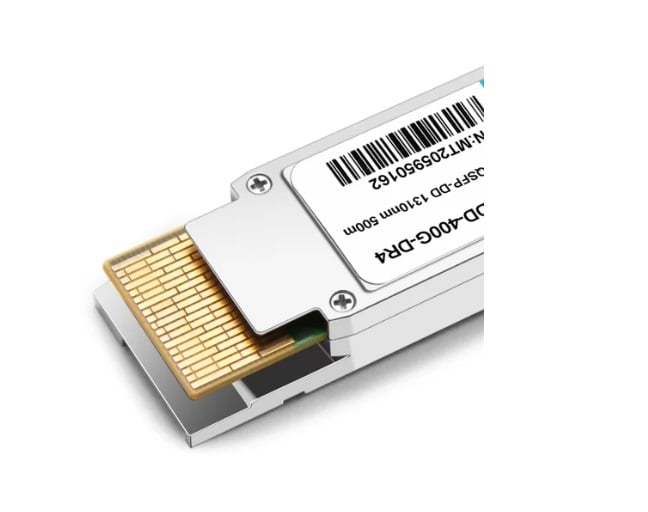
The Progression from 100G to 400G
Researching from the current best sources, I have concluded that the leap or transition from 100G standards to 400G Ethernet standards is primarily instigated by the insatiable craving for bandwidth across several verticals. The transition is enhanced by great strides in improved data transmission technological advancements such as sophisticated modulation techniques or adopting more proficient forward error correction (FEC) protocols. Furthermore, those enhancements facilitate higher data encoding rates while lowering the degree of interference of the signals, which are essential in addressing the large-scale data processing requirements typical of modern-day applications. Eventually, the history of Ethernet standards has been meant to reflect the increasing usage of IoT devices and artificial intelligence technologies, which require specific network standards to work properly. Hence, moving towards 400G is a technological advancement and a much-required evolution in the ever-growing digital universe.
The Role of the IEEE 802.3bs Standard in 400G
The IEEE 802.3bs standards are a crucial element for developing and deploying 400G Ethernet since they define the parameters for technologies aimed at transmitting data at high speed through the network. This standard deals with a variety of issues, such as the deployment of most 100G lanes in a parallel manner to increase aggregate data rate. In addition, it defines essential constraints at the physical layer to ensure the most comprehensive inter-working and to be able to cover most of the data center and service provider contours. Moreover, the standard integrates robust Forward Error Correction (FEC), which is needed to protect the data over long distances despite some expected signal deterioration. It can be concluded that the 802.3bs standard supports the implementation of 400G very softly since all future expansions will have a standard-approved template.
Future Outlook: Transitioning to 800G and Beyond
Since the need for increased capacity and speed keeps growing, the move towards 800G is expected to be a key step in networking technology. This development is mainly induced by the increasing growth of data traffic emanating from edge computing, 5G networks, and sophisticated cloud and AI applications. The deployment of 800G will be a daunting task as it will necessitate improvements on existing optical transceiver technology and advanced modulation strategies to cope with escalating data rates but, in the same breath, assure data fidelity and cut down on latencies. Also, standardization efforts, led by such bodies as the IEEE, are essential for achieving wide interoperability and universal adoption. The continuous growth of the digital world requires evolution to 800G and more in order to create the necessary base for the prospective expansion and progress in the networking sphere.
Who are the Key Players in the 400G Ethernet Market?
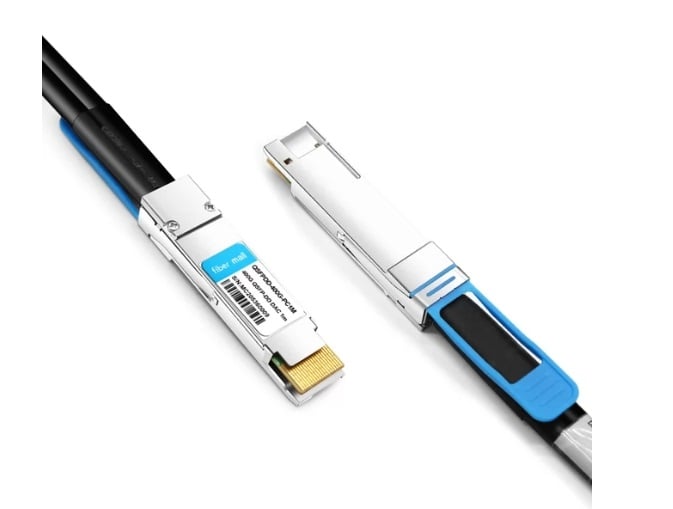
The Contributions of Cisco and Juniper
Cisco and Juniper Networks play a key role in providing 400G Ethernet services as they have solid bases ready and strong enough to dispense such services. However, Cisco markets itself based on the fact that it has expanded its 400G technology across its vast array of networking solutions, including switches, routers, and optical transceivers. Such integration allows the evolutionary upgrade of existing systems to higher ones with more bandwidth and higher scales, cisco also advocates for open networking hence the use of SDN also enhances scope for interoperability at 400G deployments.
While Cisco Systems is known for marketing advanced technologies through a broad marketing spectrum, Juniper Networks on the other hand, specializes in the provision of advanced networking technologies, particularly for the data metrics-driven applications, marking Cisco’s advancement in the 400G Ecosystem as complicated packet transport systems and high-end automated networking solutions, Increasing the usage of their products, packets for data technology has been in demand further emphasizing on increasing their sales. Further, the performance and incorporation of end-to-end solutions in the core networking system helps Juniper metrics-driven technology maximize AI and improve overall performance metrics of the core networking system; this means that both endeavor to use their strength in achieving the core backbone required for the 400G Ethernet leading to next generation of network speeds.
Advancements by Data Center Switches Manufacturers
Data center switch manufacturers continuously advance the technology to satisfy the increasing need for increased data propagation alongside decreased latency in 400G Ethernet systems. Broadcom has captured the leadership position in driving this space, mainly via its Tomahawk series of switch chipsets, which enhance the performance and efficiency to innovative levels never seen before, which are key in supporting 400G network deployment. Arista Networks is also pushing the boundaries in the data center scale with its platforms designed for scaling-out cloud networks that have higher port density and enhanced telemetry features. Another critical representative, NVIDIA (which used to be known as Mellanox Technologies), also focuses on switching solutions across its Spectrum branding, emphasizing scalable networking architecture. These manufacturers, and many others, help to boost the rapid evolution of the data center infrastructure, assuring ample and practical capacity to meet future network needs.
Innovations in Optical Transceivers and Fiber Optic Solutions
With the growth of Ethernet speed requirements, the demand for optical fibers and, more importantly, optical transceivers is indispensable. The heart of the matter at the moment is innovation in three areas. The first is a boom in silicon photonics technology, which intends to integrate monolithically optical components on silicon chips to enhance data rate and power efficiency tremendously. The second one is the rapid evolution of coherent optical transceivers, which allow over-the-horizon communication by applying advanced modulation schemes. These schemes have the potential to extend the distance whilst maintaining data integrity. The last one is the invention of DWDM, which makes it possible to simultaneously send out several signals on different wavelengths, significantly increasing the bandwidth. Altogether, these innovations set the trends in developing the speed, capacity, and reliability of optical networks.
Reference Sources
Frequently Asked Questions (FAQs)
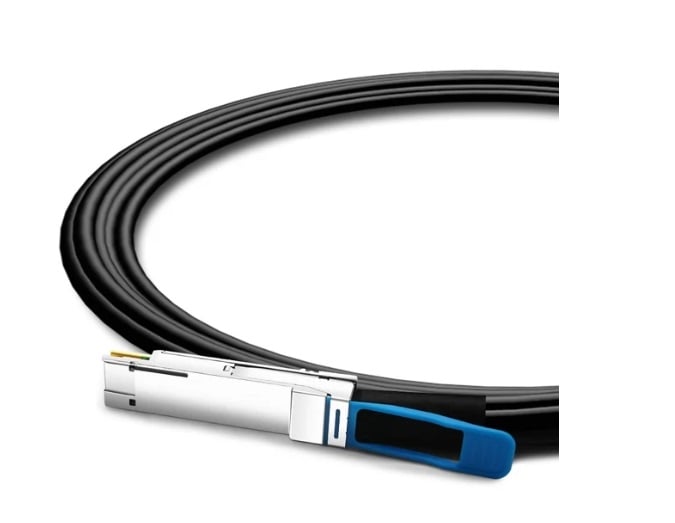
Q: What is 400G Ethernet, and how does it compare to 100Gb and other earlier standards?
A: The term 400G Ethernet, also referred to as 400GbE or 400 Gigabit Ethernet, has come to be known as the most advanced Ethernet standard that has ever been developed due to its speed of transferring data, which is 400 gigabits every second. Considering the technological advances, this is a substantial growth with the 100 Gbps standards since it provides for up to four growths. This new standard is set to enable the advancement of the rapidly burgeoning bandwidth requirements of large data centers, cloud computing environments, and high-performance network applications.
Q: What role did the IEEE 802.3bs Task Force members play in creating 400 G Ethernet?
A: The IEEE 802.3bs Task Force was responsible for developing the 400 G Ethernet core standard. This group brings together industry specialists and attempts to delineate the parameters, protocols, and guidelines for implementing 400GbE. As a result of their efforts, the IEEE 802.3bs standard was approved in December 2017, thereby setting the platform for the introduction and advancement of 400G Ethernet solutions.
Q: How does 400G Ethernet fit in the timeline towards Terabit Ethernet advancement?
A: Many view 400G Ethernet as the evolution of terabit Ethernet. It is also worth mentioning that the Ethernet development roadmap includes 400GbE as an essential transitional stage between existing 100 Gbps infrastructures and future deployment of Terabit Ethernet. The methods and experience derived from 400G deployment will certainly help develop even higher Ethernet standards in the future.
Q: What is the Difference between 200G and 400G Ethernet?
A: 200G and 400G Ethernet are both high bandwidth Ethernet standards, the 400G being two-fold with 200G. Thus, while 200 gigabit Ethernet will provide a throughput of up to 200 Gbps, 400 guys ethernet will provide up to 400 Gbps. More than two standards were developed due to the increasing bandwidth of present-day networks, however, 400G is more applicable where even greater data rates and data capacity is needed.
Q: What is the relevance of 400GBASE-DR4 and Single Mode Fiber?
A: In short, 400GBASE-DR4 is a unique construction of 400G Ethernet that employs a single-mode fiber (SMF) as its data carrier. 400GBASE-DR4 has defined the use of four lanes of 100 Gbps each to achieve a total of 400 Gbps. SMF is the fiber type appropriate for long cable runs, and it is widely employed in data center interconnects and metropolitan area networks. The 400GBASE-DR4 standard is designed to provide an efficient means of establishing high-speed connections based on single-mode fiber infrastructure.
Q: In what way does the Industry Connections Ethernet Bandwidth Assessment influence the progress of 400G Ethernet?
A: Every study related to developing new Ethernet standards, such as 400G Ethernet, has to abide by the IEEE 802.3 Industry Connections Ethernet Bandwidth Assessment. This assessment evaluates bandwidth requirements that would be in place and those that are likely to be in place shortly. The information obtained from this study also directs the technical progress of Ethernet so that new standards like 400G Ethernet are set based on the network design bandwidth demand anticipated for future networks.
Q: In modern networks, what are the main usages and advantages of 400G Ethernet?
A: 400G Ethernet is suitable for meeting the needs of and has some applications in modern networks. Its usefulness is more evident in large data centers, cloud service providers, and high-performance computing environments. 400G solutions are designed to withstand the data surge of 5G, AI, IoT and other technologies for decades to come. 400GbE and its higher transmission rates mean more data can be transferred across the network with lower latency, which increases the network space’s bandwidth capacity, enhancing system performance and scalability for high-end applications.
Related Products:
-
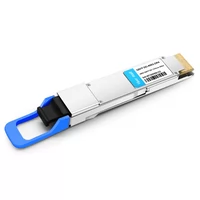 QSFP-DD-400G-DR4 400G QSFP-DD DR4 PAM4 1310nm 500m MTP/MPO SMF FEC Optical Transceiver Module
$450.00
QSFP-DD-400G-DR4 400G QSFP-DD DR4 PAM4 1310nm 500m MTP/MPO SMF FEC Optical Transceiver Module
$450.00
-
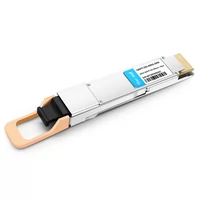 QSFP-DD-400G-SR8 400G QSFP-DD SR8 PAM4 850nm 100m MTP/MPO OM3 FEC Optical Transceiver Module
$180.00
QSFP-DD-400G-SR8 400G QSFP-DD SR8 PAM4 850nm 100m MTP/MPO OM3 FEC Optical Transceiver Module
$180.00
-
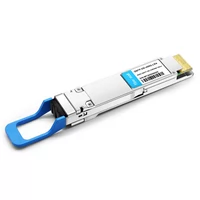 QSFP-DD-400G-LR4 400G QSFP-DD LR4 PAM4 CWDM4 10km LC SMF FEC Optical Transceiver Module
$650.00
QSFP-DD-400G-LR4 400G QSFP-DD LR4 PAM4 CWDM4 10km LC SMF FEC Optical Transceiver Module
$650.00
-
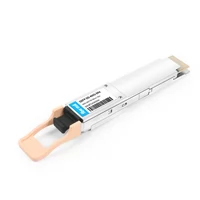 QSFP-DD-400G-SR4 QSFP-DD 400G SR4 PAM4 850nm 100m MTP/MPO-12 OM4 FEC Optical Transceiver Module
$600.00
QSFP-DD-400G-SR4 QSFP-DD 400G SR4 PAM4 850nm 100m MTP/MPO-12 OM4 FEC Optical Transceiver Module
$600.00
-
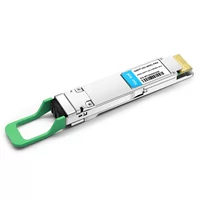 QSFP-DD-400G-FR4 400G QSFP-DD FR4 PAM4 CWDM4 2km LC SMF FEC Optical Transceiver Module
$600.00
QSFP-DD-400G-FR4 400G QSFP-DD FR4 PAM4 CWDM4 2km LC SMF FEC Optical Transceiver Module
$600.00
-
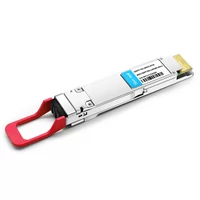 QSFP-DD-400G-ER4 400G QSFP-DD ER4 PAM4 LWDM4 40km LC SMF without FEC Optical Transceiver Module
$4500.00
QSFP-DD-400G-ER4 400G QSFP-DD ER4 PAM4 LWDM4 40km LC SMF without FEC Optical Transceiver Module
$4500.00
-
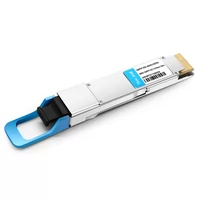 QSFP-DD-400G-XDR4 400G QSFP-DD XDR4 PAM4 1310nm 2km MTP/MPO-12 SMF FEC Optical Transceiver Module
$650.00
QSFP-DD-400G-XDR4 400G QSFP-DD XDR4 PAM4 1310nm 2km MTP/MPO-12 SMF FEC Optical Transceiver Module
$650.00
-
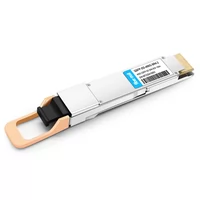 QSFP-DD-400G-SR4.2 400Gb/s QSFP-DD SR4 BiDi PAM4 850nm/910nm 100m/150m OM4/OM5 MMF MPO-12 FEC Optical Transceiver Module
$1000.00
QSFP-DD-400G-SR4.2 400Gb/s QSFP-DD SR4 BiDi PAM4 850nm/910nm 100m/150m OM4/OM5 MMF MPO-12 FEC Optical Transceiver Module
$1000.00
-
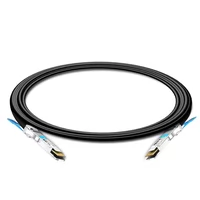 QSFPDD-400G-PC50CM 0.5m (1.6ft) 400G QSFP-DD to QSFP-DD PAM4 Passive Direct Attach Copper Twinax Cable
$80.00
QSFPDD-400G-PC50CM 0.5m (1.6ft) 400G QSFP-DD to QSFP-DD PAM4 Passive Direct Attach Copper Twinax Cable
$80.00
-
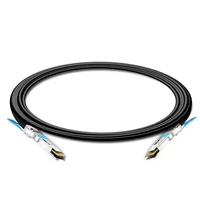 QSFP-DD-400G-AC3M 3m (10ft) 400G QSFP-DD to QSFP-DD PAM4 Active Direct Attach Copper Twinax Cable
$350.00
QSFP-DD-400G-AC3M 3m (10ft) 400G QSFP-DD to QSFP-DD PAM4 Active Direct Attach Copper Twinax Cable
$350.00
